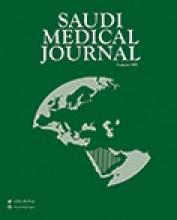Abstract
OBJECTIVE: To identify factors that increase the risk of developing febrile neutropenia (FN) during the first cycle of chemotherapy in breast cancer patients.
METHODS: In this retrospective study, we reviewed the records of 211 patients with confirmed breast cancer treated with chemotherapy at the Princess Norah Oncology Center, King Abdulaziz Medical City, Jeddah, Kingdom of Saudi Arabia between January 2010 and May 2012. Statistical analysis was conducted using descriptive analysis, univariate, and multivariate logistic regressions. A multivariate regression of FN occurrence in the first cycle was developed.
RESULTS: The median age of patients was 48 years. Febrile neutropenia was documented in 43 (20.3%) of 211 patients. Twenty-one (49%) of the 43 patients had FN during the first cycle of chemotherapy. A multivariate logistic regression revealed that age (odds ratio [OR] 1.059, 95% confidence interval [CI]: 1.007-1.114), non-anthracycline and/or taxane-based chemotherapy regimens (OR of 39.488; 95% CI: 4.995-312.187), and neo-adjuvant chemotherapy (OR of 8.282; 95% CI: 1.667-41.152) were the most important independent risk factors of FN.
CONCLUSION: Identifying risk factors of FN may help to target high-risk patients with granulocyte colony-stimulating factor prophylaxis and reduce FN incidences, with subsequent morbidities and mortalities.
- Copyright: © Saudi Medical Journal
This is an open-access article distributed under the terms of the Creative Commons Attribution-Noncommercial-Share Alike 3.0 Unported, which permits unrestricted use, distribution, and reproduction in any medium, provided the original work is properly cited.






